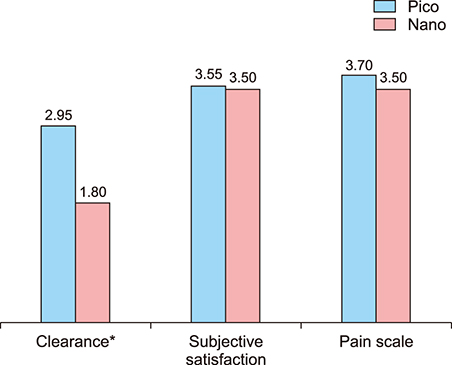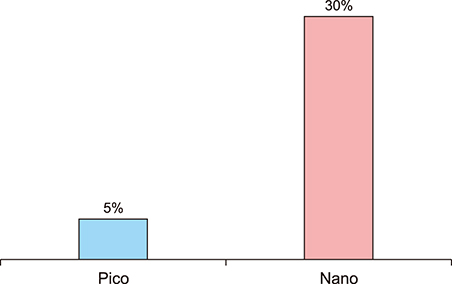Ann Dermatol.
2020 Feb;32(1):8-13. 10.5021/ad.2020.32.1.8.
A Split-Face, Single-Blinded, Randomized Controlled Comparison of 532 nm Picosecond Neodymium-Doped Yttrium Aluminum Garnet Laser versus 532 nm Q-Switched Neodymium-Doped Yttrium Aluminum Garnet Laser in the Treatment of Solar Lentigines
- Affiliations
-
- 1Department of Dermatology, Kangbuk Samsung Hospital, Sungkyunkwan University School of Medicine, Seoul, Korea. susini@naver.com
- KMID: 2467195
- DOI: http://doi.org/10.5021/ad.2020.32.1.8
Abstract
- BACKGROUND
Solar lentigines are the most common form of benign epidermal pigmentation and one of the major cosmetic concerns in Korea. A 532 nm Q-switched neodymium: yttrium-aluminum-garnet (QSND) laser is typically used for the treatment, but the occurrence of post-inflammatory hyperpigmentation (PIH) is not rare. Recently, the use of picosecond (PS) lasers has emerged in pursuit of better outcomes.
OBJECTIVE
To objectively compare the efficacy and safety of 532 nm PS and QSND lasers for the treatment of solar lentigines.
METHODS
Twenty patients with solar lentigines were enrolled in a prospective, randomized split-face, single-blind study. One side of each face was treated using a 532 nm PS laser, and the other side using a 532 nm QSND laser. After one treatment, all patients were followed up for evaluation after 2, 4, 8, and 12 weeks. The clinical clearance was assessed by three blinded dermatologists using a 5-point quartile improvement scale (QIS). Subjective satisfaction, development of PIH, pain scale during treatment, and adverse problems were also recorded.
RESULTS
Clinical clearance measured by QIS showed that the PS laser was more effective than the QSND laser. Subjective satisfaction and pain scale did not significantly differ between the two groups. The incidence of PIH was 5% in sides treated with the PS laser, and 30% with the QSND laser.
CONCLUSION
Both 532 nm PS laser and QSND laser were effective for the treatment of solar lentigines, but the PS laser was more effective with less PIH development.
Keyword
MeSH Terms
Figure
Reference
-
1. Ortonne JP. Pigmentary changes of the ageing skin. Br J Dermatol. 1990; 122 Suppl 35:21–28.
Article2. Ortonne JP, Pandya AG, Lui H, Hexsel D. Treatment of solar lentigines. J Am Acad Dermatol. 2006; 54:5 Suppl 2. S262–S271.
Article3. Anderson RR, Margolis RJ, Watenabe S, Flotte T, Hruza GJ, Dover JS. Selective photothermolysis of cutaneous pigmentation by Q-switched Nd: YAG laser pulses at 1064, 532, and 355 nm. J Invest Dermatol. 1989; 93:28–32.
Article4. Chan HH, Fung WK, Ying SY, Kono T. An in vivo trial comparing the use of different types of 532 nm Nd:YAG lasers in the treatment of facial lentigines in Oriental patients. Dermatol Surg. 2000; 26:743–749.
Article5. Noh TK, Chung BY, Yeo UC, Chang S, Lee MW, Chang SE. Q-Switched 660-nm versus 532-nm Nd: YAG laser for the treatment for facial lentigines in Asian patients: a prospective, randomized, double-blinded, split-face comparison pilot study. Dermatol Surg. 2015; 41:1389–1395.6. Levin MK, Ng E, Bae YS, Brauer JA, Geronemus RG. Treatment of pigmentary disorders in patients with skin of color with a novel 755 nm picosecond, Q-switched ruby, and Q-switched Nd:YAG nanosecond lasers: a retrospective photographic review. Lasers Surg Med. 2016; 48:181–187.
Article7. Guss L, Goldman MP, Wu DC. Picosecond 532 nm neodymium-doped yttrium aluminium garnet laser for the treatment of solar lentigines in darker skin types: safety and efficacy. Dermatol Surg. 2017; 43:456–459.
Article8. Negishi K, Akita H, Matsunaga Y. Prospective study of removing solar lentigines in Asians using a novel dual-wave-length and dual-pulse width picosecond laser. Lasers Surg Med. 2018; 50:851–858.
Article9. Yoshimura K, Harii K, Aoyama T, Iga T. Experience with a strong bleaching treatment for skin hyperpigmentation in Orientals. Plast Reconstr Surg. 2000; 105:1097–1108. discussion 1109-1110.
Article10. Todd MM, Rallis TM, Gerwels JW, Hata TR. A comparison of 3 lasers and liquid nitrogen in the treatment of solar lentigines: a randomized, controlled, comparative trial. Arch Dermatol. 2000; 136:841–846.
Article11. Negishi K, Akita H, Tanaka S, Yokoyama Y, Wakamatsu S, Matsunaga K. Comparative study of treatment efficacy and the incidence of post-inflammatory hyperpigmentation with different degrees of irradiation using two different quality-switched lasers for removing solar lentigines on Asian skin. J Eur Acad Dermatol Venereol. 2013; 27:307–312.
Article12. Ho SG, Yeung CK, Chan NP, Shek SY, Chan HH. A comparison of Q-switched and long-pulsed alexandrite laser for the treatment of freckles and lentigines in oriental patients. Lasers Surg Med. 2011; 43:108–113.
Article13. Friedmann DP, Peterson JD. Efficacy and safety of intense pulsed light with a KTP filter for the treatment of solar lentigines. Lasers Surg Med. 2019; 51:500–508.
Article14. Forbat E, Ali FR, Al-Niaimi F. Applications of picosecond lasers beyond tattoos: pigment reduction and tissue remodeling. Lasers Med Sci. 2017; 32:1219.
Article15. Chan JC, Shek SY, Kono T, Yeung CK, Chan HH. A retrospective analysis on the management of pigmented lesions using a picosecond 755-nm alexandrite laser in Asians. Lasers Surg Med. 2016; 48:23–29.
Article
- Full Text Links
- Actions
-
Cited
- CITED
-
- Close
- Share
- Similar articles
-
- Acquired Dermal Melanocytosis of the Nose Successfully Treated with Neodymium-doped Yttrium Aluminum Garnet 1064 nm Laser
- Perioral Hyperpigmentation Treated with 1,064-nm Q-switched Neodymium:Yttrium-aluminum-garnet Laser Toning
- Hypopigmentation Induced by Frequent Low-Fluence, Large-Spot-Size QS Nd:YAG Laser Treatments
- Partial Unilateral Lentiginosis Successfully Treated with a High-fluence 1,064-nm Q-switched Neodymium:Yttriumaluminum-garnet Laser
- Macular Pigmentation Following Low Fluence Nd:YAG Laser Procedure at Sites of Gold Thread Implantation





